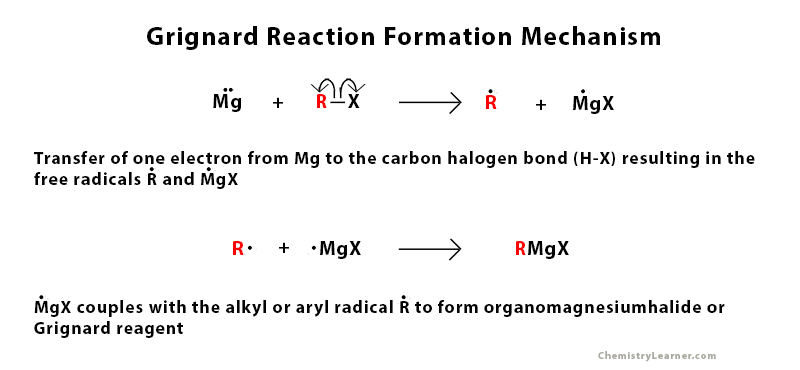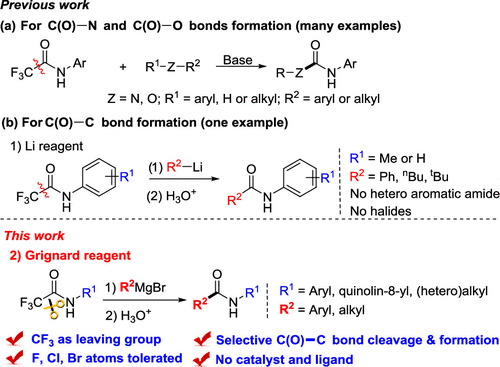
ABSTRACT:
In this article, we will discuss about the synthesis and reactions of Grignard reagent. Grignard reagents organometallic compounds widely used in organic synthesis due to their exceptional reactivity and versatility. They have played a pivotal role in the development of modern organic chemistry. We will also discuss the mechanisms of these reactions. We will provide references to understand the concept deeply.
INTRODUCTION OD SYNTHESIS AND REACTIONS OF GRIGNARD REAGENT:
Grignard reagents, discovered by French chemist Victor Grignard in 1900, organometallic compounds widely used in organic synthesis. These reagents, typically formed by the reaction of an alkyl or aryl halide with magnesium metal, are highly reactive and versatile, making them valuable tools in the construction of complex organic molecules.
SYNTHESIS AND REACTIONS OF GRIGNARD REAGENT:
1. SYNTHESIS OF GRIGNARD REAGENT:
The synthesis of Grignard reagents involves the reaction of an alkyl or aryl halide with magnesium metal in anhydrous conditions. The reaction typically carried out in an ether solvent, such as diethyl ether or tetrahydrofuran (THF), to prevent the formation of unwanted side products. The reaction is highly exothermic and requires careful control of temperature and addition rate.
MECHANISM OF GRIGNARD REAGENT:
The mechanism of Grignard reagent formation involves a nucleophilic substitution reaction between the alkyl or aryl halide and magnesium metal. The reaction proceeds through a radical intermediate, where the magnesium atom undergoes a single electron transfer to the halogen atom, resulting in the formation of a magnesium halide and a carbon-centered radical. This radical then reacts with another magnesium atom to form the Grignard reagent.

2. REACTIONS OF GRIGNARD REAGENT:
Grignard reagents known for their ability to act as strong nucleophiles and bases, allowing them to participate in a wide range of reactions. Some of the most common reactions involving Grignard reagents include:
a) FORMATION OF ALCOHOL FROM CARBONYL COMPOUNDS:
One of the most common reactions involving Grignard reagents is the addition to carbonyl compounds, leading to the formation of alcohols. The addition of a Grignard reagent to an aldehyde or a ketone generates a metal alkoxide intermediate, which can hydrolyze to form the corresponding alcohol. This reaction, known as the Grignard reaction, has widely applied in synthetic chemistry for the preparation of various alcohol derivatives.

b) SYNTHESIS OF CARBOXYLIC ACIDS:
Another important transformation enabled by Grignard reagents is the formation of carboxylic acids. After the addition of a Grignard reagent to carbon dioxide, an intermediate magnesium carboxylate formed. Upon hydrolysis, carboxylic acids obtained. This reaction, also known as the Grignard carboxylation, allows for the synthesis of a range of carboxylic acids, including fatty acids and aromatic acids.

c) FORMATION OF C-C BOND:
Grignard reagents are widely employed in the formation of carbon-carbon (C-C) bonds. By reacting Grignard reagents with various electrophiles, such as alkyl halides, acid chlorides, or epoxides, new carbon-carbon bonds can be created. These reactions, including the Grignard coupling and the Grignard cross-coupling reactions, are versatile tools for the construction of complex organic structures.

d) NUCLEOPHILIC ADDITION TO UNSATURATED COMPOUNDS:
Grignard reagents can also react with unsaturated compounds, such as alkenes and alkynes, resulting in nucleophilic addition reactions. The addition of a Grignard reagent to an alkene or alkyne leads to the formation of alkyl or alkenyl magnesium halides. These reactive intermediates can further undergo transformations to produce diverse functionalized compounds, playing a vital role in the synthesis of natural products and pharmaceuticals.

e) REDUCTIVE PROCESSES:
Grignard reagents can act as reducing agents in various chemical transformations. They can reduce a variety of functional groups, such as carbonyl compounds, by transferring an electron to the substrate. This feature makes Grignard reagents invaluable in the synthesis of complex organic molecules by providing efficient and selective means for reduction reactions.
CONCLUSION:
Grignard reagents are powerful tools in organic synthesis, offering a wide range of reactions and transformations. Their ability to act as strong nucleophiles and bases makes them invaluable in the construction of complex organic molecules. Understanding the synthesis and reactions of Grignard reagents, along with their detailed mechanisms, allows chemists to design and execute efficient synthetic routes. By harnessing the reactivity of Grignard reagents, researchers continue to make significant contributions to the field of organic chemistry.
REFERENCES:
Grignard, V. (1900). Sur quelques nouvelles combinaisons organométaliques du magnésium et leur application à des synthèses d’alcools et d’hydrocarbures. Comptes Rendus Hebdomadaires des Séances de l’Académie des Sciences, 130(20), 1322-1325.
Clayden, J., Greeves, N., & Warren, S. (2012). Organic Chemistry. Oxford University Press. https://global.oup.com/academic/product/organic-chemistry-9780199270293?cc=pk&lang=en&
Smith, M. B., & March, J. (2007). March’s Advanced Organic Chemistry: Reactions, Mechanisms, and Structure. John Wiley & Sons. https://rushim.ru/books/mechanizms/march6ed.pdf
Clayden, J., Greeves, N., & Warren, S. (2012). Grignard reagents: Nucleophilic addition to the electrophilic groups. In Organic chemistry (p. 456). Oxford University Press.

